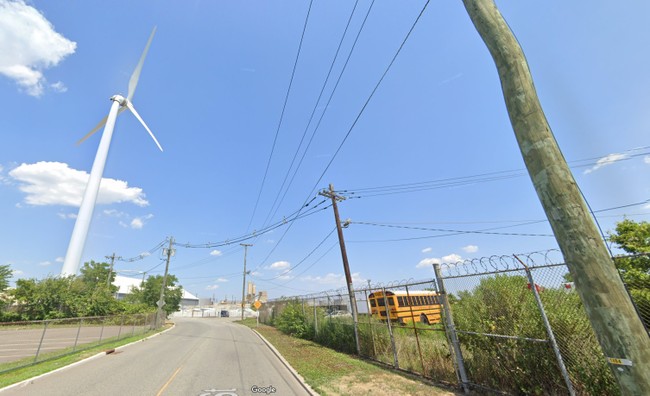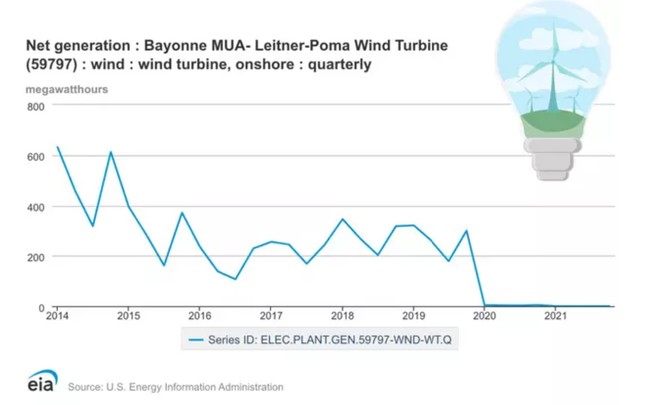This is another of those "Oh, Coulda Told Ya" stories that you find just grab your attention when you're reading up on other related things. I mean, you have to chase it down.
After all the time we've spent documenting the foils, trials, lies, and travails as New Jersey's rodential governor feverishly attempts to sell his state's offshore glories to the wind and climate cult lobby, who knew there was a lone NJ sentinel bearing mute and lifeless witness to the folly of wind standing in plain sight all along.
In, of all places, that urban, Garden State paradise known as "Bayonne."
Why, even 50 years ago, SNL recognized Bayonne for its unique and exotic properties in their memorable Navy recruiting ad send-up:
PORT OF CALL: BAYONNE, NEW JERSEY
The story of the Bayonne wind turbine began during another Democratic president's cash-a-palooza.
Barack Obama had a bazillion dollars ($840B) to blow on "shovel-ready jobs" in his flashy and fruitless effort to pull the country out of what was called "The Great Recession." He also had willing partners in sleazy Democratic governors more than willing to snarf up whatever largesse he and the Democratic Congress were willing to fork over.
One of those weasels with his furry paw out was NJ Governor and former CEO of collapsed brokerage firm IM Global Jon Corzine (What is it with New Jersy?). Corzine had a plan and a place to dump the cash.
...The project began in the gloomy days of the Great Recession. In 2009, President Barack Obama signed the American Recovery and Reinvestment Act, which aimed to jump-start the economy by pouring $840 billion into energy infrastructure and other projects. Obama said he wanted “shovel-ready” projects that could ramp up quickly.
Across the country, political leaders scrambled to come up with proposals that would be eligible for the sudden shower of federal dollars. Jon Corzine, New Jersey’s governor at the time, “wanted a green-energy project,” recalls Boyle. Soon, wheels were turning to build a wind turbine on the grounds of a Bayonne wastewater facility.
In theory, the plan made a lot of sense. “Water plants and the like are great places for turbines because of their high electrical load,” says renewable energy analyst Paul Gipe. Building a turbine right where the power is needed eliminates the losses that occur when electricity travels over long distances.
The location chosen for the turbine is in a low-rise industrial zone, though the nearest houses are just a few hundred feet away. Engineers determined that noise from the system wouldn’t be detectable above background noise and that the blades’ shadows would almost never fall over nearby homes.
As with everything the government - from federal to state - touches, nothing went according to plan. The US-based turbine supplier pulled out of the project, so they went with a different firm, which has offices in the US, but their turbines are built in Italy. Also, there were a number of site issues because no one had ever dropped a towering turbine willy-nilly in the middle of an urban area before. So all the bugs, issues, objections, and anticipated future possible problems had to be worked out, and the municipal/federal codes rewritten to allow it.
Classically, it took the turbine almost three years before it saw its first whoosh of blades.
...Still, hopes were high when the turbine’s blades finally started turning in June 2012. Electricity from the system would power two wastewater pumping stations, helping save the city about $175,000 a year in electricity costs.
When the turbine cranked out more juice than the pumps demanded, that would be sold back to the power utility, earning rebates for the city. It was estimated that the project could save Bayonne $7 million over 25 years. For a city that had long struggled economically, that was good news.
“It seemed to cheer people up,” recalls Armstrong. “People saw it as something nice and clean and bright.” And the turbine delivered as promised, helping cut the city’s electricity bill dramatically.
Pretty, isn't it?

The turbine crapped out for the first time in June of 2015 and stayed that way for a good, long while. If you've ever owned a Fiat or Ferrari you know what getting replacement Italian parts is like.
...“It’s very proprietary technology,” Boyle says. “You can’t just call up Joe Mechanic to work on it.”
Each month that the turbine was out of service cost the city more than $25,000 in lost electricity savings and rebates. Worse, the unit was no longer under warranty.
“We were terrified we were going to get stuck with the full cost of the repairs,” Boyle recalls. (Leitner-Poma did not respond to several calls seeking comment.)
By the time the turbine was back in service the following March, repair costs had ballooned to more than $800,000. The city’s insurance only paid about half. “It was an expensive repair,” Boyle says. “But you don’t walk away from a $5 million asset.”
No, you don't walk away from a $5.6M asset, especially if you didn't pay for it to begin with.
You know who did? American taxpayers fronted the city of Bayonne $4.7M of the cost and the state kicked in almost $870K.
Poor (they literally are) Bayonne sucked up the turbine repair bill, and the ensuing electricity bills for their plant and finally got the turbine spinning again.
For another six months, then the brakes came on. Well, to be honest, the problem was more that they couldn't.
Less than half a year after the city's wind turbine was repaired, it has stopped working again, the Bayonne Municipal Utilities Authority confirmed.
This time, the problem is with a rotor brake part that isn't working and needs to be replaced, MUA Executive Director Tim Boyle said.
Can you imagine? I'll bet you can.
And those estimates of operational longevity just don't hold up across the board with these turbines, do they?
...Meanwhile, the estimated cost of replacing the broken bearing was $298,000. Boyle said the MUA is still in negotiations with Leitner-Poma over how much the MUA should pay for that.
He has previously said that the bearing that broke was supposed to last 20 years but only lasted three.
The little turbine that couldn't was really starting to get kinda a bad rap even with people who hadn't paid for it to begin with.
...Papers started calling it the “on-again, off-again wind turbine.” “Stop saving us money with this thing,” read an online comment on one article. “We can’t afford it anymore.”
Now, the NY Post article I've used for the bulk of my background here is from 2019 and was written in sort of a celebratory, "glad we got this ironed out" tone, from the headline to the last paragraphs.
How this New Jersey town’s $5.6M wind turbine became a blessing and a curse
...In the end, Bayonne could have done worse with its pioneering wind facility. “I think it is going pretty well, overall,” says Armstrong, who is no longer involved with the project.
While it hasn’t saved as much money as anticipated, it remains a financial plus for the city. And, by helping replace electricity made from fossil fuels, it significantly reduces the city’s carbon footprint.
Yeah. About that.
As we say in the profession, "Oops."
This is an article from last year - 2023. Check what the headline says:
Deal soon expected to fix wind turbine that hasn’t spun in N.J. city since 2020
WHUT
Oh, yes. It stopped spinning in 2020, less than a year after the chirpy Post article, and stopped for good.
At first, this baffled and bemused everyone—even two years later, when the situation had torqued-off city officials wondering if it had been installed correctly to begin with.
The turbine earned itself another nickname in the meantime - THE NOTORIOUS BAYONNE TURBINE.
The notorious Bayonne turbine, which was supposed to have paid for operations of the Oak Street sewerage facility, may not have been installed correctly, city officials concluded last week.
“The turbine hasn’t worked more than half the time since it was first installed,” Bayonne’s Law Director, Jay Coffey, said at a recent meeting, adding that city officials are seeking to get answers. “We’re in negotiations with the company to see what we can do.”
This includes dealing with the corporate offices located in Italy, as well as those here in the United States, he said.
Interesting factoid there, too, about operations. That the turbine has barely worked half the time it had been up.
Ah, the tale of the tape...as it falls off a cliff.

That steaming pile of fiberglass and steel has been an inert pylon in the sky since shortly after the Pollyanna piece appeared in the Post - darn near four years now.
This turbine is doing great work in Bayone . 🤣🤣🤣 I think it hasn't worked longer than it has worked. We can't even get the turbines that are already installed to work. #stopthewindfarm #stoptheturbines #newjersey#saveourshore pic.twitter.com/ZRoAxrocBl
— New Jersey Project (@fight4newjersey) July 30, 2023
The Post article had it right - there is a lesson in Bayonne's trials and tribulations, but it ISN'T that wind is the answer. Wind proves it over and over again.
The story of the notorious Bayonne turbine also proves that the only thing saving that ugly hunk of junk is the fact that the town didn't pay for it - you and I did. It wouldn't exist and cannot exist without subsidies.
The city can't afford it, and it was free.
New Jersey's object lesson in renewables has been sitting in a Bayonne sewer plant all along.
Appropriate, don't you think?








Join the conversation as a VIP Member